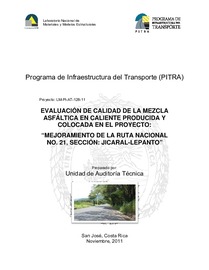EVALUACIÓN DE LA CALIDAD DE MEZCLA ASFÁLTICA PRODUCIDA Y COLOCADA EN EL PROYECTO: MEJORAMIENTO DE LA RUTA NACIONAL N°21, SECCIÓN: JICARAL-LEPANTO
Date
2011-11Author
Cervantes Calvo, Víctor
Sequeira Rojas, Wendy
Chaverri Jiménez, Jenny
Loría Salazar, Luis Guillermo
Metadata
Show full item recordAbstract
Al evaluar el espesor de la carpeta asfáltica colocada se determinó que 5 de los 17 núcleos extraídos presentaron un espesor inferior a los 5 cm que se requieren para el proyecto. A l analizar estos resultados por medio de los índices de calidad se demostró que el espesor de la mezcla asfáltica colocada presenta una variabilidad significativa (24,10%).
Con respecto a la tolerancia del diseño de mezcla, se evidenció que el porcentaje de agregado que pasa la malla N°30 sobrepasa el límite superior dado la especificación.
Como resultado del análisis de la consistencia del diseño de mezcla se evidenció que el hecho de producir mezcla asfáltica en la totalidad del rango óptimo de contenido de asfalto implica un riesgo potencial de incumplimiento de las especificaciones contractuales para los parámetros de contenido de vacíos de la mezcla y vacíos llenos de asfalto (VFA), lo cual no asegura la calidad de la mezcla asfáltica producidas.
Es importante reiterar que la toma de muestras del proyecto por parte de la Auditoría Técnica dentro del proceso de fiscalización, no tiene como finalidad cumplir la función del control ni la verificación de calidad y tampoco le corresponde a esta Auditoría Técnica, realizar evaluaciones exhaustivas a nivel de proyecto que son de competencia propia de la Administración, por lo que el presente informe no es un dictamen final de la calidad del proyecto Jicaral-Lepanto, sino un insumo para que la Administración realice una revisión de los resultados obtenidos por el LanammeUCR, en contraste con los controles propios, tanto de la verificación como del control de la calidad por parte del contratista, controles que deben existir en todo proyecto de obra vial. While evaluating the thickness of the placed asphalt folder it was determined that 5 of the 17 cores extracted had a thickness of less than 5 cm that are required for the project. Analyzing these results by means of quality indices showed that the thickness of the asphalt mix was significantly different (24.10%).
Respecting the tolerance of mix design, it was shown that the percentage of aggregate passing through mesh No. 30 exceeds the upper limit given the specification.
As a result of the mix design consistency analysis it was shown that the fact of producing asphalt mixture over the entire optimum range of asphalt content entails a potential risk of non-compliance with the contractual specifications for the parameters of voids content and voids filled with asphalt (VFA), which does not assure the quality of the asphalt mixture produced.
It is important to reiterate that the Technical Audit's sampling of the project within the audit process is not intended to fulfill the control or quality verification function and it is not the responsibility of this Technical Audit to carry out comprehensive assessments at level of the project, which is responsibility of the Administration, due that, this report is not a final opinion on the quality of the Jicaral-Lepanto project but an input for the Administration to perform a review of the results obtained by the LanammeUCR, in contrast with the own controls, both of the verification and of the quality control by the contractor, controls that must exist in all project of road works.
Collections
- Informes [1102]

